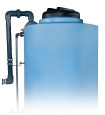When storing chemicals, it isn’t enough to select a tank material that works for a while. You need to ensure that your storage solution remains safe, reliable, and cost-effective for years to come.
Topics:
Fittings and Accessories
Proper tank filling operations directly impact your facility's safety record, product loss rates, and operational efficiency. The right fill line system does more than simply moving chemicals from delivery trucks to storage tanks. It also minimizes spill risks, protects personnel, and can significantly reduce filling time while preventing costly product waste.
Topics:
Fittings and Accessories
Many industrial chemical applications use mixers to create products, keep chemicals in suspension, treat wastewater, or dilute the chemical. Polyethylene tanks are well equipped to handle that type of process, as most chemicals can be safely combined.
Topics:
Fittings and Accessories
Certain chemicals — such as ferric, alum, and hydrochloric acid — can be inherently higher temperature chemicals. To avert catastrophic failure of your chemical storage tank, a margin of safety is required to manage risk.
Topics:
Fittings and Accessories
Poly Processing manufactures a wide variety of storage tank systems that are compatible with many different chemicals, including fuming chemicals that must be securely sealed when stored. For these chemical applications, the use of a fume-tight lid is usually required. Let’s take a closer look at how a fume-tight lid functions, when a fume-tight lid might be required, and what options are available to meet your chemical storage needs.
Topics:
Venting,
Fittings and Accessories
On January 9, 2014, a chemical spill fouled the water supply for thousands of West Virginians in the U.S. A hazardous chemical used for washing coal called 4-methylcyclohexane methanol, or “crude MCHM,” leaked from an industrial facility into the Elk River near Charleston, West Virginia. The incident could have been prevented if a proper secondary containment system had been in place.
Topics:
Fittings and Accessories
For over five decades, Poly Processing has been at the forefront of innovation in chemical storage tank design and manufacturing. Reinforcing our commitment to advancing crosslinked polyethylene (XLPE) tank technology, we are thrilled to unveil our latest update to our storage tank solutions: the 15,500-gallon IMFO tank, the 15,000-gallon Sloped Bottom IMFO tank, and the 15,500-gallon Vertical tank, are all available in specific gravities up to 2.2 design. These large innovative XLPE tanks are designed for exceptional durability, reliable performance, and an extended lifespan across a variety of applications. To enhance protection and prolong service life in oxidative environments, such as those involving sodium hypochlorite, they can be manufactured with our industry-leading OR-1000 engineered resin system, known for its remarkable resistance to oxidative chemicals. These tanks represent the best engineering and design in the tank manufacturing industry, and they are covered under PPC’s industry-leading warranty. At Poly Processing, we’re focused on delivering high-quality, forward-thinking solutions to meet the evolving demands of the chemical storage industry.
Topics:
Fittings and Accessories,
Applications
When a chemical storage tank fails, the costs can be significant to your organization. Regulatory concerns, environmental cleanup, property damage, and injury to employees can be costly exposures. Let’s take a look at a few of the reasons chemical storage tanks fail.
Topics:
Fittings and Accessories
If you're storing chemicals that emit fumes such as hydrochloric acid or hydrogen peroxide, you need to have a proper venting system in place. We've developed The PolyScrub™ fume scrubber to help you ensure the safety of your employees, equipment, and the environment.
Topics:
Fittings and Accessories
Poly Processing Company has established a close working relationship with a large, international name brand paint manufacturer. In doing so, we are able to provide customized solutions for large bulk storage tanks containing paint ingredients as well as finished paint products. In this article, we’ll examine this partnership with leading paint manufacturers.
Topics:
Fittings and Accessories



